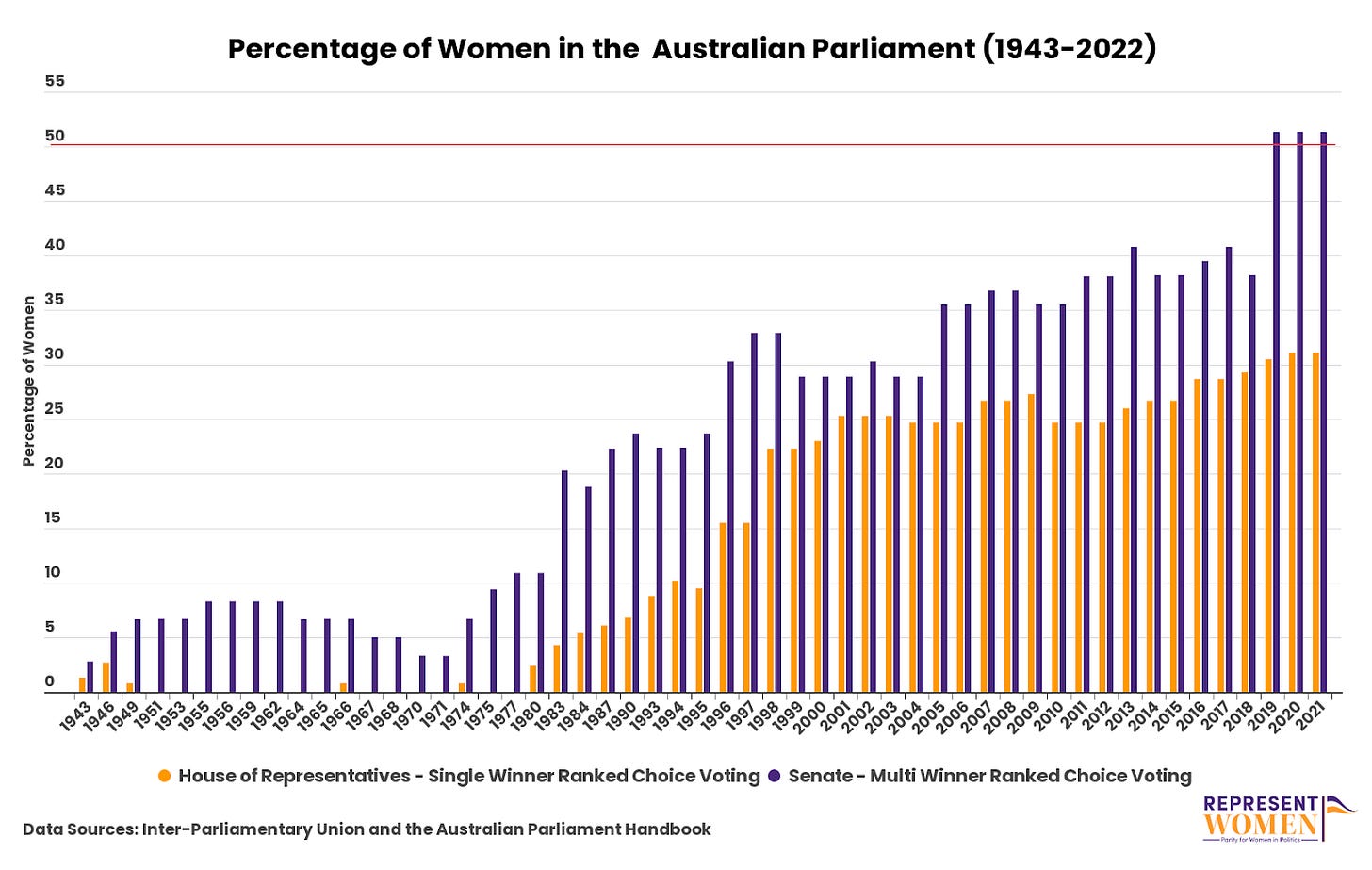Headlines: Australian women lead a revolution of independent candidates
Ranked choice voting election shakes up the establishment
“Teal” is not a color usually associated with politics. Red, blue, black and green are linked to specific political parties – but teal? That color is usually associated with bathroom towels or a plaid tablecloth. It signals domesticity and a white picket fence wrapped around a lovely yard.
That is, until the recent Australian elections on May 21, when woman candidates running independent of the two major parties delivered a small political earthquake. They became known as “teal independents,” based on their campaign colors, and after the post-election dust had settled, they had knocked off a number of incumbents in the House of Representatives, beat the Rupert Murdoch media machine, and now control important swing votes that will decide the strength of a bare parliamentary majority.
The topmost issues of this election included women’s equality, climate action, and ties with Australia’s giant neighbor, China. And though the women elected are political moderates – the teal color was chosen because they saw themselves as blending the economics of blue conservatives with the climate policies of green candidates – ultimately the Teal Independents backed a return to power for the center-left Australian Labor Party. With only a two-seat majority, the new Labor prime minister, Anthony Albanese, then appointed a record number of women as cabinet members and in other ministries. In the newly formed government, there are 10 women in the 23-member cabinet and a total of 19 women in the prime minister’s 42-member team. In the House of Representatives as a whole, women won 38% of the seats (compared to the US House, where women hold only 27.6% of the seats.
But the background story of how this shakeup happened is equally important. The Australian electoral system – known as the alternative vote, instant runoff, or ranked choice voting –has been in use Down Under for over 100 years. It played a key role in this reinvigoration of the Australian political class. An electoral system is usually a silent partner in the political constellation; it operates quietly in the background, like the operating system of a computer, taking our data (in this case votes) and processing it according to the rules of the pre-existing software program (in this case, the vote tabulation method).
Indeed, the electoral system is the operating system of any representative democracy. We usually ignore it, assuming that our way must be the only way to count votes. But just as there are differences between the Apple iOS operating system and the MS-DOS operating system of Microsoft Windows, or the Android operating system of Google, different electoral systems counting the same votes according to different rules will produce completely different elected representatives and partisan majorities.
The quiet power of ranked choice voting
What happened in Australia is a fascinating example of the power of ranked choice voting to interject new voices and new ideas into a country’s politics. It shows the potential for introducing a “third force” into the usual political inertia that can break gridlock and release the animal spirits of a democracy.
I’ll let Malcolm Turnbull, the former prime minister of Australia from the conservative Liberal Party, explain how this shakeup happened:
“Australia has preferential or ranked choice voting, where electors have to write a number against each candidate’s name indicating the order in which they are preferred…The Teal Independents in Australia were running against Liberal incumbents, most of whom would normally get a first-preference vote of 50% or more. However if [the Teal Independents] could take a substantial part of that and get the incumbent’s primary vote down to 40% or less, and if they ran second, they would probably win with the benefit of Labor and Green preferences. And this is more or less what happened.”
As Turnbull further explains, previously his Liberal Party had been a big tent conservative party, but in recent years it was captured by the political right and Rupert Murdoch’s media empire. On several issues, especially climate change in Australia, it was dragged to a position that did not reflect the values of many of its longtime conservative voters.
“But the flexibility of preferential voting meant that an independent could come through the middle, offering voters policies and personalities that they wanted,” says Turnbull. “People power trumped Murdoch.”
The Teal Independents, quite remarkably, captured seven of the Liberal party’s safest seats. Combined with three other seats won in earlier elections, this means that some of the Liberal party’s safest seats are now held by independents, all women, who persuaded thousands of lifelong Liberal voters to defect. Some ballots are still being counted, but independent candidates appear to have won a total of 10 seats in the House, Greens increased their seat share from one to four, and two other small parties won one seat each. According to FairVote’s Jeremy Seitz-Brown, the two major parties won a record low of first rankings, while independents and minor parties won a record high of first rankings. The new government, with its two-seat majority, will need support from some of these newcomers, depending on the issue.
The Labor Party’s victory brings a change in government after nine years of conservative rule, in which the two conservative parties, the Liberal Party and the National Party, formed a coalition government. For decades, these two conservative parties have used the ranked ballots to run collaboratively instead of spoiling each other. But in this election, the ranked ballots allowed independent newcomers to stitch together a new coalition in key Liberal Party strongholds that blended conservative economics and green climate policies. While the election was a wipeout for the conservative coalition, it did not translate into a landslide victory for Labor due to the success of the independent candidates and Greens, courtesy of ranked choice voting. RCV offered voters the chance to vote for their favorite candidates without worrying that those candidates and parties will act as spoilers, or split the vote among like-minded voters.
More lessons: the power of multi-seat districts and proportional representation
There is another lesson to be learned from the Australian election about the impact of electoral systems. While representatives in the House are elected using ranked choice voting in single-seat districts, in the Australian Senate another method is used. Known as “proportional representation,” it still uses ranked ballots -- but with multiple seats within each district, instead of one seat per district. So this is a real-world test about the impact of electoral systems, since the same voters in the same election expressed their electoral choices simultaneously using two different methods.
For those interested in broad and fair representation, the results show some intriguing differences. In the Senate election, conducted according to the rules of proportional ranked choice voting, women won 24 of the 40 of contested seats, or 60%. But in the one-seat districts, women won substantially less, 38% of the seats (which, as we have seen, is still much higher than the 27.6% women’s representation in the US House). The Green Party won 15.8% of the seats (12 out of 76) in the Australian Senate, but only 2.6% (four out of 151) in the House.
FairVote’s Jeremy Seitz-Brown says the US “could expect many positive features of Australia’s political system to be replicated here” if Congress were to adopt a proportional ranked choice voting method to elect our federal legislature. “Like in Australia,” says Seitz-Brown, “one chamber (the U.S. Senate) would use single-winner RCV, and one chamber (the U.S. House) would use proportional RCV. Women would fare much better with multi-member U.S. House districts, and ‘bridge-building’ candidates should win more seats and help prevent the hyperpolarization and gridlock” that is grinding our system to a halt.
“While important differences between our political cultures exist,” says Seitz-Brown, “the United States would benefit from learning a thing or two from the ‘land down under’.” Fortunately, FairVote has led the charge to lobby Congress to adopt the Fair Representation Act, which would transform our “winner take all” elections to proportional representation based on ranked choice voting and multi-seat districts.
Steven Hill, @StevenHill1776






Another excellent well-researched piece by Hill. I suppose the Australian "teal" is our "purple." And we surely could use more purple here. Fortunately the quiet power of ranked-choice voting and proportional representation is growing. I'm constantly confounded by the critics of RCV/PR claiming it's too confusing. (Hey, if the Aussies have been able to figure it out for a few years, and the citizens of the Big Apple did get through it once, it can't be rocket science.) Or, as critics also say, it's too new and needs to be thoroughly tested. (Sure, over a century of successful use down under is encouraging, but you can't be too careful.)
Alas, I fear critics of RCV/PR have concerns unrelated to those they claim publicly - not exactly an unknown phenomenon in political life. Could they be skeptical of democracy in general and of those pesky voters specifically? If so their opposition to RCV/PR is quite understandable. Anything improving democracy and empowering voters is to be resisted. RCV/PR puts our elections dangerously close to that slippery slope leading to precisely those "problems."